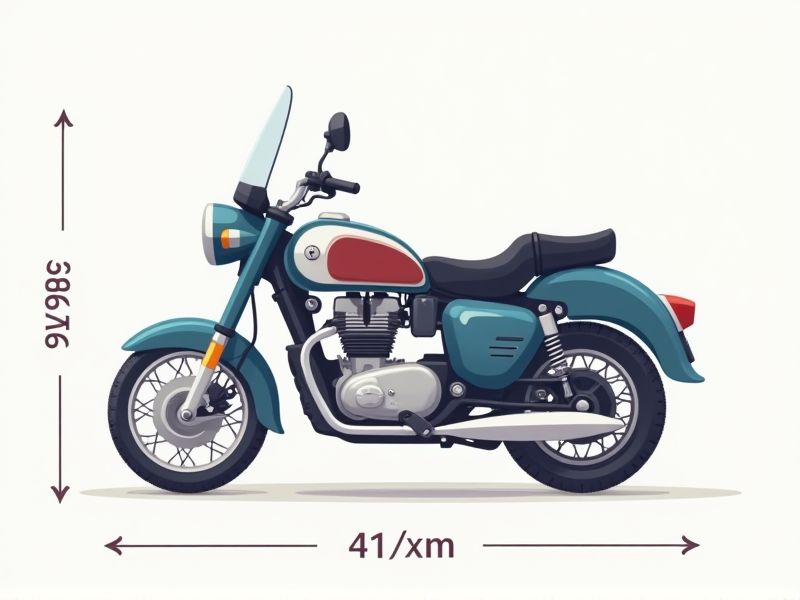
When considering standard dimensions for a motorcycle, the specifics can vary depending on the type and style of bike, but a typical street motorcycle usually measures around 2,000 mm (78-80 inches) in length and 700-900 mm (28-35 inches) in width. The average seat height is roughly 800 mm (31 inches), making it suitable for most adult riders, while the wheelbase is typically about 1,400 mm (55 inches). These dimensions ensure maneuverability and comfort for everyday riding. However, it's always important to check the manufacturer's specifications for the exact measurements of your chosen model, as sport bikes, cruisers, and touring motorcycles will differ.
Wheelbase Length
The wheelbase length of a motorcycle significantly influences its stability and handling characteristics. Typically, sport motorcycles feature a wheelbase ranging from 52 to 57 inches, providing agility for quick turns and acceleration. In contrast, cruiser motorcycles often measure between 62 and 68 inches, enhancing stability during long rides. Understanding the wheelbase can help you choose a motorcycle that best suits your riding style and preferences.
Seat Height
Seat height is a critical specification when selecting a motorcycle, particularly for new riders or those with shorter inseams. Standard seat heights typically range from 28 to 34 inches, influencing your ability to control the motorcycle while stopped. A lower seat height, around 28 to 30 inches, provides better confidence in footing, whereas sport and touring models may exceed 31 inches, potentially challenging for shorter riders. When evaluating motorcycles, consider the seat height alongside your inseam measurement to ensure a comfortable and secure riding experience.
Overall Width
The overall width of a motorcycle significantly impacts its handling, stability, and maneuverability. For standard motorcycles, this width typically ranges from 30 to 38 inches, providing a balance between comfort and control. A broader stance can enhance stability during high-speed rides, while a narrower design facilitates easier navigation in urban environments. Understanding your motorcycle's overall width is crucial for ensuring it fits your riding style and needs.
Overall Length
The overall length of a standard motorcycle typically ranges between 2,100 mm to 2,300 mm, depending on the model and manufacturer. This dimension significantly impacts handling, stability, and rider comfort during extended rides. A longer motorcycle often provides better straight-line stability, making it suitable for touring and cruising. However, it can be less maneuverable in tight urban settings, so consider your riding style when selecting a motorcycle.
Handlebar Width
The standard handlebar width for motorcycles typically ranges from 28 to 32 inches, depending on the type and design of the bike. This measurement plays a crucial role in rider comfort, control, and overall handling. Wider handlebars provide improved leverage and stability, especially at high speeds or when navigating tight corners, while narrower options may enhance agility for more aggressive riding styles. When selecting a motorcycle, consider how handlebar width can impact your riding experience and ergonomics.
Ground Clearance
Ground clearance is a critical specification for motorcycles, as it typically ranges from 140 mm to 200 mm depending on the model and purpose. A higher ground clearance enhances off-road capabilities by preventing obstacles from scraping the undercarriage, while a lower clearance can improve stability and handling on paved roads. For example, adventure bikes often boast ground clearance upwards of 200 mm, making them suitable for rugged terrain, whereas sport bikes generally have around 130 mm for optimized aerodynamics and cornering. Evaluating ground clearance is essential to ensure your motorcycle aligns with your riding preferences and the environments you navigate.
Fuel Tank Capacity
The average fuel tank capacity for motorcycles typically ranges from 3 to 6 gallons, depending on the type and model. Sports bikes often feature smaller tanks, around 3.5 gallons, to maintain a lightweight design and enhance performance. Touring motorcycles, on the other hand, can accommodate larger tanks, frequently exceeding 5 gallons, allowing for extended travel without frequent refueling stops. When considering your next motorcycle, evaluating fuel tank capacity is crucial for long-distance rides and overall riding experience.
Tire Size
Motorcycle tire size is crucial for performance and safety, typically measured in a format like 120/70-ZR17. This indicates the tire's width, aspect ratio, and rim diameter, with the first number representing the width in millimeters. A wider tire can provide better grip, while a narrower tire may enhance agility and responsiveness. For optimal performance, ensure your motorcycle's tires match the manufacturer's specifications based on model and intended use.
Weight
When considering motorcycle performance, weight plays a crucial role in handling and agility. The average modern motorcycle weighs between 300 to 600 pounds, with lighter models often weighing around 300 pounds. A lighter motorcycle not only improves acceleration but also enhances braking efficiency, allowing for a more responsive ride. For enthusiasts, a weight-to-power ratio around 1:1 is often seen as optimal for a thrilling experience.
Frame Size
Frame size is crucial for motorcycle performance and rider comfort, with major manufacturers offering sizes that accommodate different heights and weights. Most models range from 15 to 36 inches in seat height, impacting your ability to reach the ground safely. A well-fitted frame not only enhances stability but also improves handling, especially in tight corners where precision is essential. Assessing your inseam measurement against the motorcycle's frame size can significantly enhance your riding experience and reduce the risk of accidents.
